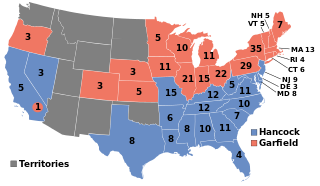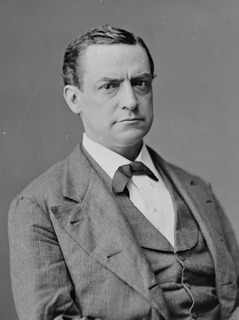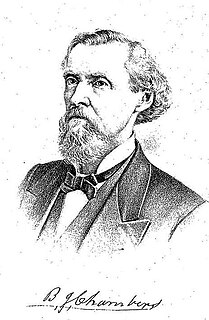The Independent Reform Party, sometimes also known as the Anti-Monopoly Party, [1] was a short-lived political party in Illinois, in the United States. Arising out of the disorder created by the fracturing of the Republican Party in 1872, when the Liberal Republican Party had been created, it was organized on June 10, 1874, in a convention at Springfield. [2] It fielded candidates in that year's elections but disappeared thereafter.

Illinois is a state in the Midwestern and Great Lakes region of the United States. It has the fifth largest gross domestic product (GDP), the sixth largest population, and the 25th largest land area of all U.S. states. Illinois is often noted as a microcosm of the entire United States. With Chicago in northeastern Illinois, small industrial cities and immense agricultural productivity in the north and center of the state, and natural resources such as coal, timber, and petroleum in the south, Illinois has a diverse economic base, and is a major transportation hub. Chicagoland, Chicago's metropolitan area, encompasses over 65% of the state's population. The Port of Chicago connects the state to international ports via two main routes: from the Great Lakes, via the Saint Lawrence Seaway, to the Atlantic Ocean and from the Great Lakes to the Mississippi River, via the Illinois Waterway to the Illinois River. The Mississippi River, the Ohio River, and the Wabash River form parts of the boundaries of Illinois. For decades, Chicago's O'Hare International Airport has been ranked as one of the world's busiest airports. Illinois has long had a reputation as a bellwether both in social and cultural terms and, through the 1980s, in politics.

The United States of America (USA), commonly known as the United States or America, is a country composed of 50 states, a federal district, five major self-governing territories, and various possessions. At 3.8 million square miles, the United States is the world's third or fourth largest country by total area and is slightly smaller than the entire continent of Europe's 3.9 million square miles. With a population of over 327 million people, the U.S. is the third most populous country. The capital is Washington, D.C., and the largest city by population is New York City. Forty-eight states and the capital's federal district are contiguous in North America between Canada and Mexico. The State of Alaska is in the northwest corner of North America, bordered by Canada to the east and across the Bering Strait from Russia to the west. The State of Hawaii is an archipelago in the mid-Pacific Ocean. The U.S. territories are scattered about the Pacific Ocean and the Caribbean Sea, stretching across nine official time zones. The extremely diverse geography, climate, and wildlife of the United States make it one of the world's 17 megadiverse countries.
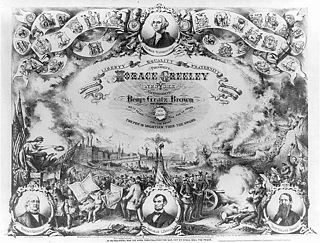
The Liberal Republican Party of the United States was an American political party that was organized in May 1872 to oppose the reelection of President Ulysses S. Grant and his Radical Republican supporters in the presidential election of 1872. The party emerged in Missouri under the leadership of Senator Carl Schurz and soon attracted other opponents of Grant. The party opposed Grant's Reconstruction policies and sought civil service reform. It lost in a landslide and disappeared after the 1872 election.
Contents
The platform of the Independent Reform Party called for budget cuts, the repeal of the National Bank Act, and the institution of an inflationary currency policy based on the greenback. It criticized the corruption of the existing parties, focusing on corrupt ties between government and the railroad industry: the party demanded an end to railroad land grants and the giving of free railroad passes to elected officials, and strict enforcement of the existing railroad laws. [2] This platform was also endorsed by the state convention of the Liberal Republican Party under former Illinois governor John M. Palmer, [2] with the exception of the currency plank. [3]
The National Banking Acts of 1863 and 1864 were two United States federal banking acts that established a system of national banks, and created the United States National Banking System. They encouraged development of a national currency backed by bank holdings of U.S. Treasury securities and established the Office of the Comptroller of the Currency as part of the United States Department of the Treasury and a system of nationally chartered banks. The Act shaped today's national banking system and its support of a uniform U.S. banking policy.
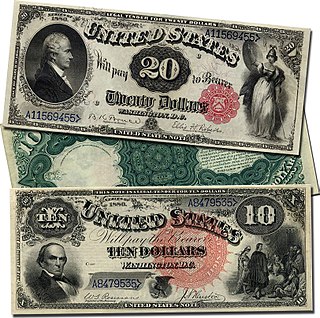
A United States Note, also known as a Legal Tender Note, is a type of paper money that was issued from 1862 to 1971 in the U.S. Having been current for 109 years, they were issued for longer than any other form of U.S. paper money. They were known popularly as "greenbacks", a name inherited from the earlier greenbacks, the Demand Notes, that they replaced in 1862. Often termed Legal Tender Notes, they were named United States Notes by the First Legal Tender Act, which authorized them as a form of fiat currency. During the 1860s the so-called second obligation on the reverse of the notes stated:
This Note is a Legal Tender for All Debts Public and Private Except Duties On Imports And Interest On The Public Debt; And Is Redeemable In Payment Of All Loans Made To The United States.

John McAuley Palmer was an Illinois resident, an American Civil War General who fought for the Union, the 15th Governor of Illinois, and presidential candidate of the National Democratic Party in the 1896 election on a platform to defend the gold standard, free trade, and limited government.
At the convention, Richard Rowett had argued forcefully for the party platform to support the gold standard, but he was defeated by advocates of inflation. [2] [4] A provision that would have insisted on the full payment of the national debt was also defeated. [4]

Richard Rowett was a leading political figure of nineteenth-century Illinois, a famous animal breeder and an officer in the Union Army during the American Civil War.
Several Independent Reform Party representatives were elected to the 29th Illinois General Assembly in 1874. [5] There they joined other reform parties and independents in caucusing with the Democrats, giving that party a majority in both chambers and control of the leadership. [6] However, the tensions between Democrats and reformers made the 29th General Assembly unusually turbulent. [6]

The 29th Illinois General Assembly was elected in November 1874. The session began on January 6, 1875 and adjourned on April 15, 1875. No party had a majority in either chamber. The Republicans had a plurality in both chambers, with 24 members in the Senate and 69 in the House, but control of the chambers was held by a coalition of Democrats, third parties, and independents.
At the statewide level, the Independent Reform Party nominated David Gore for Treasurer and Samuel Etter for Superintendent of Public Instruction. Etter was also nominated by the Democrats, and thus was elected by a narrow 30,000-vote margin, while Gore was defeated by 35,000 votes. [1] [7]

